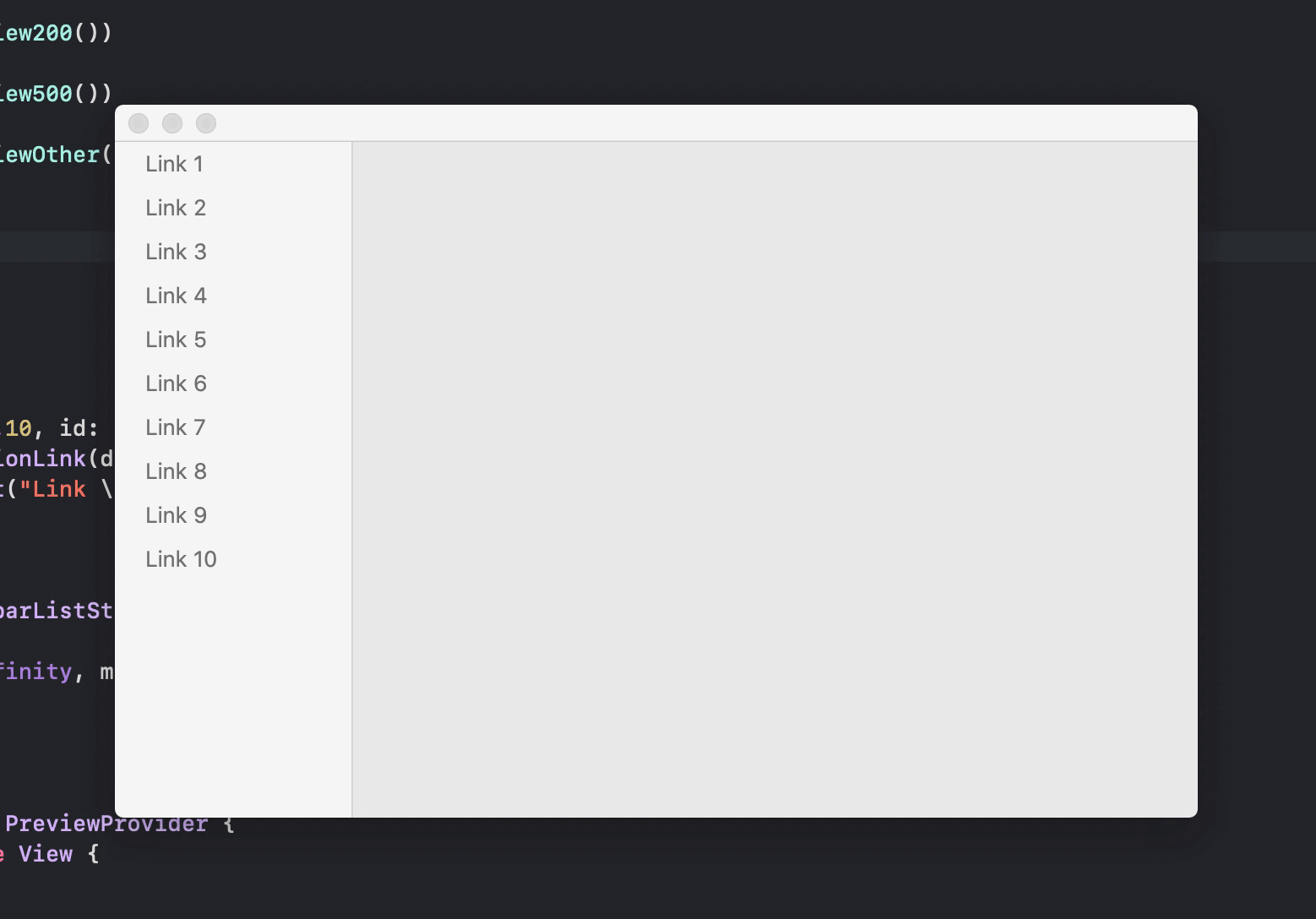I'm using SwiftUI for a Mac app where the main window contains a NavigationView. This NavigationView contains a sidebar list. When an item in the sidebar is selected, it changes the view displayed in the detail view. The views presented in the detail view are different sizes which should cause the size of the window to change when they are displayed. However, when the detail view changes size the window does not change size to accommodate the new detail view.
How can I make the window size change according to the size of the NavigationView?
My example code for the app is below:
import SwiftUI
struct View200: View {
var body: some View {
Text("200").font(.title)
.frame(width: 200, height: 400)
.background(Color(.systemRed))
}
}
struct View500: View {
var body: some View {
Text("500").font(.title)
.frame(width: 500, height: 300)
.background(Color(.systemBlue))
}
}
struct ViewOther: View {
let item: Int
var body: some View {
Text("\(item)").font(.title)
.frame(width: 300, height: 200)
.background(Color(.systemGreen))
}
}
struct DetailView: View {
let item: Int
var body: some View {
switch item {
case 2:
return AnyView(View200())
case 5:
return AnyView(View500())
default:
return AnyView(ViewOther(item: item))
}
}
}
struct ContentView: View {
var body: some View {
NavigationView {
List {
ForEach(1...10, id: \.self) { index in
NavigationLink(destination: DetailView(item: index)) {
Text("Link \(index)")
}
}
}
.listStyle(SidebarListStyle())
}
.frame(maxWidth: .infinity, maxHeight: .infinity)
}
}
struct ContentView_Previews: PreviewProvider {
static var previews: some View {
ContentView()
}
}
And here is what the example app looks like when the detail view changes size:

Here is demo of possible approach that works. I did it on one different view, because you will need to redesign your solution to adopt it.
Demo

1) The view requiring window animated resize
struct ResizingView: View {
public static let needsNewSize = Notification.Name("needsNewSize")
@State var resizing = false
var body: some View {
VStack {
Button(action: {
self.resizing.toggle()
NotificationCenter.default.post(name: Self.needsNewSize, object:
CGSize(width: self.resizing ? 800 : 400, height: self.resizing ? 350 : 200))
}, label: { Text("Resize") } )
}
.frame(minWidth: 400, maxWidth: .infinity, minHeight: 200, maxHeight: .infinity)
}
}
2) Window's owner (in this case AppDelegate)
import Cocoa
import SwiftUI
import Combine
@NSApplicationMain
class AppDelegate: NSObject, NSApplicationDelegate {
var window: NSWindow!
var subscribers = Set<AnyCancellable>()
func applicationDidFinishLaunching(_ aNotification: Notification) {
let contentView = ResizingView()
window = NSWindow(
contentRect: NSRect(x: 0, y: 0, width: 480, height: 300), // just default
styleMask: [.titled, .closable, .miniaturizable, .resizable, .fullSizeContentView],
backing: .buffered, defer: false)
window.center()
window.setFrameAutosaveName("Main Window")
window.contentView = NSHostingView(rootView: contentView)
window.makeKeyAndOrderFront(nil)
NotificationCenter.default.publisher(for: ResizingView.needsNewSize)
.sink(receiveCompletion: {_ in}) { [unowned self] notificaiton in
if let size = notificaiton.object as? CGSize {
var frame = self.window.frame
let old = self.window.contentRect(forFrameRect: frame).size
let dX = size.width - old.width
let dY = size.height - old.height
frame.origin.y -= dY // origin in flipped coordinates
frame.size.width += dX
frame.size.height += dY
self.window.setFrame(frame, display: true, animate: true)
}
}
.store(in: &subscribers)
}
...
Asperi's answer works for me, but the animation is not working on Big Sur 11.0.1, Xcode 12.2. Thankfully, the animation works if you wrap it in an NSAnimationContext:
NSAnimationContext.runAnimationGroup({ context in
context.timingFunction = CAMediaTimingFunction(name: .easeIn)
window!.animator().setFrame(frame, display: true, animate: true)
}, completionHandler: {
})
Also it should be mentioned that ResizingView and window don't have to be initialized inside AppDelegate; you can continue using SwiftUI's App struct:
@main
struct MyApp: App {
@NSApplicationDelegateAdaptor(AppDelegate.self) var appDelegate
var body: some Scene {
WindowGroup {
ResizingView()
}
}
}
class AppDelegate: NSObject, NSApplicationDelegate {
var window: NSWindow?
var subscribers = Set<AnyCancellable>()
func applicationDidBecomeActive(_ notification: Notification) {
self.window = NSApp.mainWindow
}
func applicationDidFinishLaunching(_ aNotification: Notification) {
setupResizeNotification()
}
private func setupResizeNotification() {
NotificationCenter.default.publisher(for: ResizingView.needsNewSize)
.sink(receiveCompletion: {_ in}) { [unowned self] notificaiton in
if let size = notificaiton.object as? CGSize, self.window != nil {
var frame = self.window!.frame
let old = self.window!.contentRect(forFrameRect: frame).size
let dX = size.width - old.width
let dY = size.height - old.height
frame.origin.y -= dY // origin in flipped coordinates
frame.size.width += dX
frame.size.height += dY
NSAnimationContext.runAnimationGroup({ context in
context.timingFunction = CAMediaTimingFunction(name: .easeIn)
window!.animator().setFrame(frame, display: true, animate: true)
}, completionHandler: {
})
}
}
.store(in: &subscribers)
}
}
If you love us? You can donate to us via Paypal or buy me a coffee so we can maintain and grow! Thank you!
Donate Us With